He’s not a crook; he just plays one in a comic book: 13 appearances of Richard Milhous Nixon in comic books.
By JOHN DiBELLO
It’s Presidents Day! This is a great opportunity to take a three-day holiday, buy an on-sale mattress, or sit at home and not receive any mail. But we should also use the occasion to reflect upon all 43 historical presidents (sorry, Grover Cleveland, we’re only counting you once), not merely Lincoln and Washington again. From the depths of history, Zachary Taylor shouts “Hooray!”
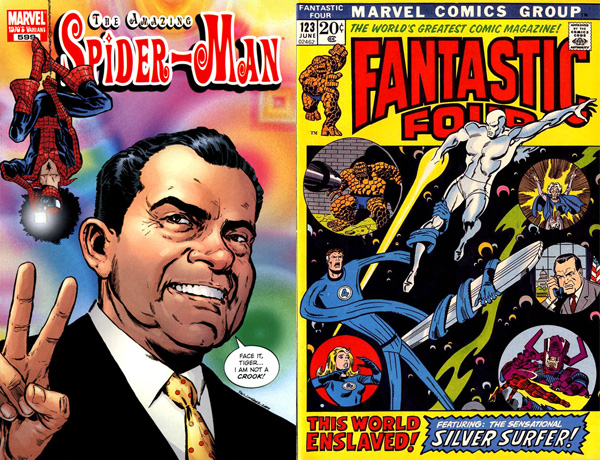
Nixon in Marvel comic books: on the covers of Amazing Spider-Man #599 (2009), art by Phil Jimenez; and Fantastic Four #123 (1972), art by Sal Buscema
But since this is 13th Dimension, and because there never was a comic book titled Millard Fillmore Two-in-One, let’s focus upon a single president. What president? Well, it’s an obvious choice, right? Richard Nixon!
1. Nixon as supporting character
During his one-and-a-half terms as president, Nixon made various appearances in Marvel Comics as Commander-in-Chief. If he was in charge of the U.S. Army, it makes perfect sense that he’s also responsible for overseeing S.H.I.E.L.D. Dig Nixon’s mod televiewer and his bright green jacket — a suit color you only seem to get in comics.
For quite a long period in the early 1970s, Nixon appeared so frequently in the Hulk’s comic that he might have been a regular member of the cast.
Say, why wasn’t Kissinger there? Why, maybe he was off brokering a non-aggression pact with Doctor Doom. Smooth move, Henry.
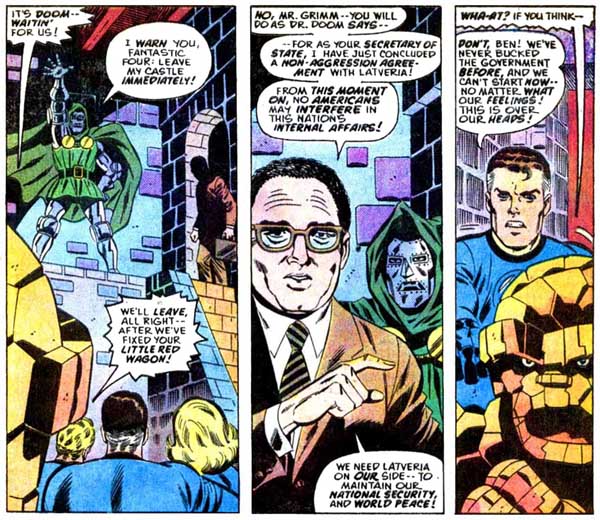
Super-Villain Team-Up #6 (Marvel, 1976), script by Steve Englehart, art by Herb Trimpe and Jack Abel
—
2. Nixon as Earth celebrity
Today we might not quite believe it, but at the time aliens were skeptical too: This guy was our president?!?
A far-seeing alien from Jupiter must convince his comrades of the existence of not only Earth but also this peace sign-flashing leader called “Nee-Xon.” He’s promptly taken away to a room padded with the finest in Jovian space rubber. But say, why does the caption in this final panel mention Martians?

From Beyond the Unknown #17 (DC, 1972), script by Otto Binder, art by Carmine Infantino and Joe Giella
That’s because the story is an edited reprint from 15 years before, originally starring Martians…
…concerned with a leader named “Izen-Hower.”
When the story was reprinted in ’72, it was updated to include the current president. Somebody missed that one tell-tale panel! The setting was changed from Mars to Jupiter, presumably because we knew a lot more about Mars by 1972 — for example, we all knew that aliens from Mars are green and look like J’onn J’onnz.
—
3. Nixon as historical figure
Biographical, true-life comic books were mostly a thing of the past by the time of Nixon’s administration, but here’s a rare historical look at the 37th President in one of the Spire Christian Comics of the 1970s. Born Again is a comic book adaptation of Nixon aide Chuck Colson’s autobiography, covering his involvement in Nixon’s administration, and his conversion to born-again Christianity.
The comic stops short of outright accusing Nixon of his major role in the Watergate conspiracy, focusing instead on Colson’s tribulations and religious conversion — the fall of Nixon isn’t the focus or intent of this comic. He is still wearing that god-awful green suit, though.
—
4. Nixon as dastard
Michael Kupperman, on the other hand, doesn’t hesitate to accuse, try, and convict Richard Nixon of one of the greatest crimes of the twentieth century: trying to blow up the Apollo 11 astronauts with explosive sandwiches.
He would’ve gotten away with it, too, if it wasn’t for those meddling kids and their dog!
—
5. Nixon as alien invader
During Marvel’s Secret Invasion, it turned out that nearly everybody was a Skrull! Nobody mentioned that one of the original Skrull sleeper agents had been in place since at least the 1950s. Yep, it’s Nixon again, as one of the green knobby-chinned shape-shifters!

Avengers Forever #5 (Marvel, 1999), script by Roger Stern and Kurt Busiek, art by Carlos Pacheco and Jesus Merino
Why didn’t anyone in the Marvel Universe remember Dick Nixon as a Skrull? Well, what they didn’t know is that time master Immortus exposed him in public …
… and then promptly erased the timeline from history, making it never-was. Since it never existed, therefore, please tear up your copies of Marvel Premiere #37 and Avengers Forever #5. These comic books no longer exist.
—
6. Nixon as sleaze
You can’t accuse comics writer and artist John Byrne of being ambivalent on the subject of Richard Nixon. Byrne portrays Nixon as sweaty, unshaven, and petulant, whether he’s in the Marvel Universe…
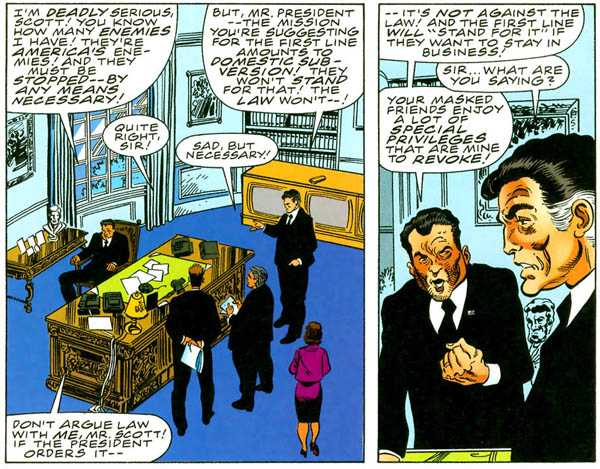
Marvel: The Lost Generation #7 (Marvel, 2000), script by Roger Stern and John Byrne, art by John Byrne and Al Milgrom
… the DC Universe…
… or even in the Star Trek universe, where he gooses the young Teri Garr.
Hands off the Star Trek spin-off supporting cast, Dick!
—
7. Nixon as American Dream
Like one of the Ghosts of Christmas, Nixon visits Prez Rickard, who will become the first teen President. In Gaiman’s Sandman series, though, you can’t always take nighttime visions literally. Nixon’s appearance may be just a dream within a dream, but he echoes what he believes the office is: power, money, sex, and a robot in the Hall of Presidents. It’s nice, therefore, to see the incorruptible Prez perplex Nixon. Perhaps, Prez promises himself, and all us American Dreamers, that there is more to the presidency after all.
—
8. Nixon as supervillain
Steve Englehart, who wrote several other satirical portrayals of Richard Nixon in Marvel’s superhero comics, took the concept of Nixon as conspirator and crook to its natural conclusion (well, natural for the Marvel U, that is).
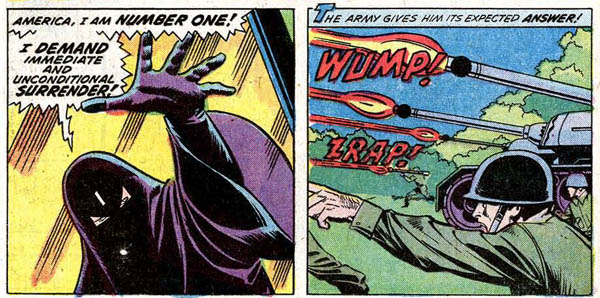
Captain America #175 (Marvel, 1974), script by Steve Englehart, art by Sal Buscema and Vince Colletta
While it’s never specifically stated “on screen” that supervillain Number One of the Secret Empire is Nixon, it’s highly suggested, and Captain America is staggered by not only the revelation of the leader of his country as a crook but also “Number One’s” suicide before his eyes.
This shocking turn influenced the Cap comic for many months following and led to the storyline of Steve Rogers abandoning the Captain America persona in a deep crisis of faith in his country. Instead, Steve became “Nomad,” the Man without a Country. It’s likely a SHIELD LMD finished out Nixon’s final days in office.
—
9. Nixon as world diplomat
A far more sympathetic portrayal puts Nixon on a spaceship alongside United Nations secretary general (a true historical personage) and Jimmy Olsen (who we all wish was a true historical personage) to investigate an alien incursion on the moon.
No fear: The aliens came to give us the message of peace. For once in comics, Nixon does exactly what a representative of one of the world’s leading countries should do: flies into outer space to check it out. Now, that Nixon I’d vote for. Um, if it wasn’t for all the bugging and secret tape-erasing and covering-upping.
—
10. Nixon as metaphor
It’s not the real Dick Nixon who faces off against Dr. Stephen Strange on the mystic plane, but an uncanny simulation. Well, a guy in a rubber mask, at least, representing the dreads and fears Strange must overcome. Strange is pretty good at dispatching “Nixon’s” henchmen, but when it comes to battling the fake Nixon …
Well, fake Nixon cheats. No surprise in a story written by Steve Englehart. Spoiler warning: Dr. Strange eventually wins, triumphs over his doubts, beats Nixon, goes out and gets a chili dog.
—
11. Nixon as monster
Lots of people accused Nixon of being a crook, but nobody’s ever accused a comic starring Deadpool of being subtle, so the 2013 “Dead Presidents” storyline pitted Deadpool against every deceased president, resurrected zombie-style.
While it’s difficult to accept the notion of Washington, Lincoln, and Franklin Roosevelt as shambling, destroying monsters, it seems oddly apt (if not subtle) and appropriate to resurrect Nixon as a supernatural villain. It’s ironic, then, that Duggan and Posehn give Zombie Nixon a (slightly) sympathetic moment: He’s angry at the Watergate Hotel, not humanity.
Zombie Gerry Ford, however, goes out full Chevy Chase pratfall style.
—
12. Nixon as disembodied head
Matt Groening’s no fan of Richard Nixon, either. Nixon appears as a villain in “The Simpsons” and many Bongo comic books. In Futurama (both TV cartoon and comic) Nixon gets his deepest skewering, as the power-mad Presidential Head In A Jar. Generally a background or cameo character, Nixon’s Head occasionally takes a starring role as a true villain, and the writers of Futurama, like those on the original Star Trek, use stories to parody our own must-be-learned history. Here, Nixon attempts to starts another Vietnam/Iraq-type War … in space!
—
13. Nixon as historical winner
Perhaps the most cautionary depiction of Nixon in comic books is in Watchmen, which posits an alternate history based on the rise of superhumans. The story focuses on the costumed heroes, but it’s Nixon who benefits tremendously from the changes in history over our universe. Like the rest of Watchmen’s structure, Nixon’s rise is a puzzle — the pieces are out of order but all there, waiting to be assembled. Thanks to the involvement of Dr. Manhattan, the Vietnam War is an easy win under Nixon’s administration.
Nixon’s close connection to highly skilled assassin Comedian ensures that Woodward and Bernstein’s Watergate scoop is never revealed.
Winning Vietnam puts Nixon’s approval ratings through the roof, allowing him to have the 22nd Amendment repealed and win a third presidential term.
In 1985, under the red lights of a Pentagon war room, Nixon considers the sure-to-come nuclear war, one that’s all but assured to destroy half of America.
It isn’t until the closing days of the comics’ events that we see Nixon as he is “now”: haggard, worn, and white-haired, as he heads to a nuclear bunker to wait out the inevitable war.
But Nixon is Nixon to the end: still arrogant and self-assured, even as he cradles the nuclear “football” and waits for the end of the world.
Richard Nixon is about to have his historical fat hauled out of the alternate history fire by superhumans once again: The plot by Ozymandias to unite the world’s governments against a possible alien threat is successful. We’re not shown the immediate political result, but since Ozymandias is behind the scenes, you can imagine who takes the credit for averting war and creating the new “golden” age of co-operation with Russia: Richard M. Nixon.
There’s one final, small, but telling note in the last pages of Watchmen that shows us Nixon’s story, successful as it might have been, is winding down: The Republicans are backing actor Robert Redford as a 1988 presidential candidate, and Nixon’s five terms of office will come to an end.
“History is written by the winners,” the old adage goes, although an addendum to that might be “Alternate history is written by an author who doesn’t want to take credit for it anymore. And Harry Turtledove.” Alan Moore’s portrayal of Nixon riding the changes in his history to a success rather than an ignoble, disgraced failure, is a fine metaphor for the portrayal of a president in a comic book, but as fiction, no less valid than, say, Skrull Nixon or Zombie Nixon or Nixon in a space capsule with Jimmy Olsen. Storytelling is the grand purpose of comic books, as is history, and the winners are the ones we’ll remember for the future.
Whoops — did I forget to mention Nixon as duck?
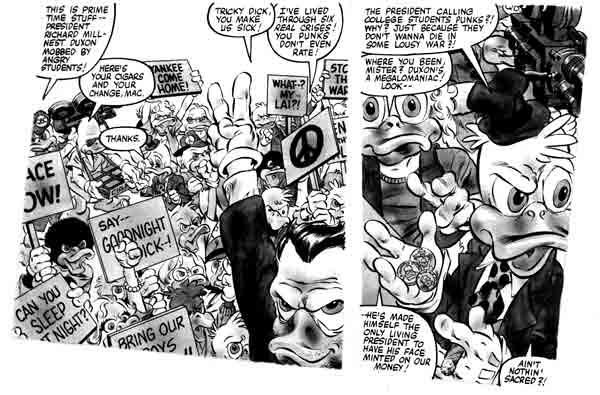
Howard the Duck Magazine #6 (Marvel, 1980), script by Bill Mantlo, art by Michael Golden and Bob McLeod
Leave a comment! We promise it won’t be recorded!

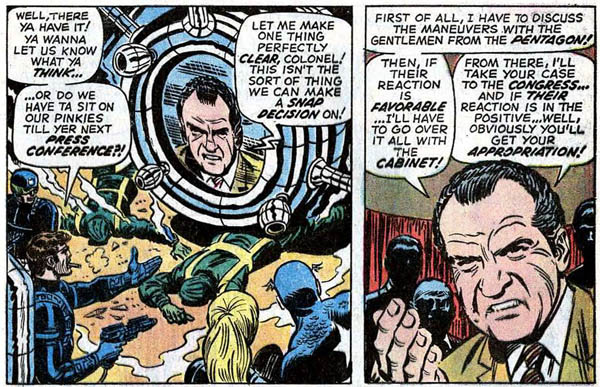
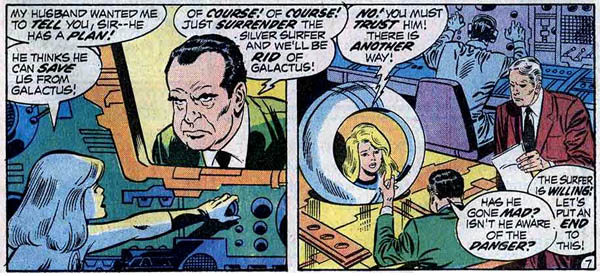
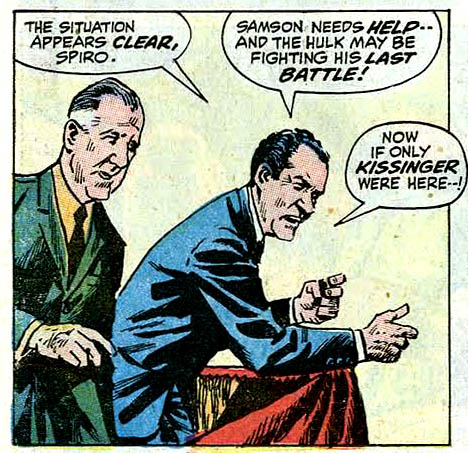
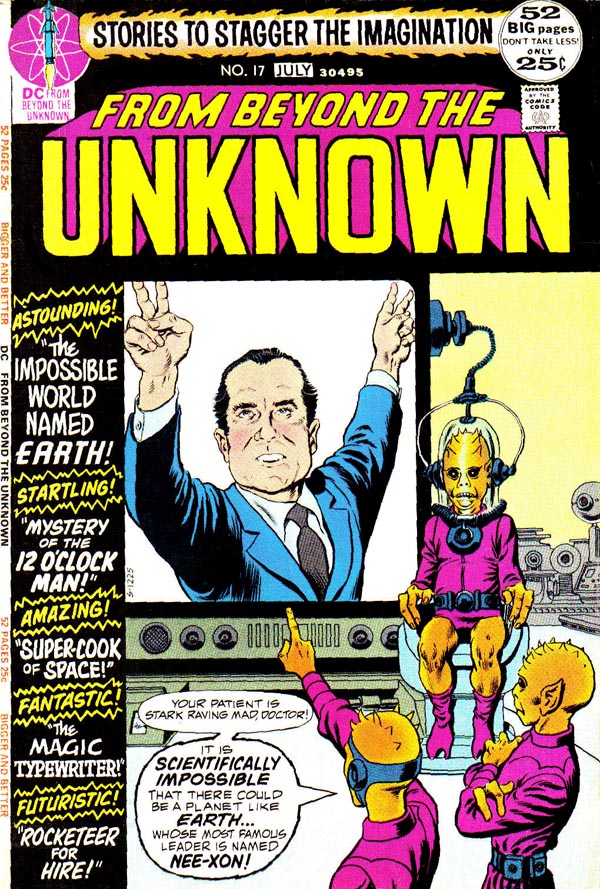


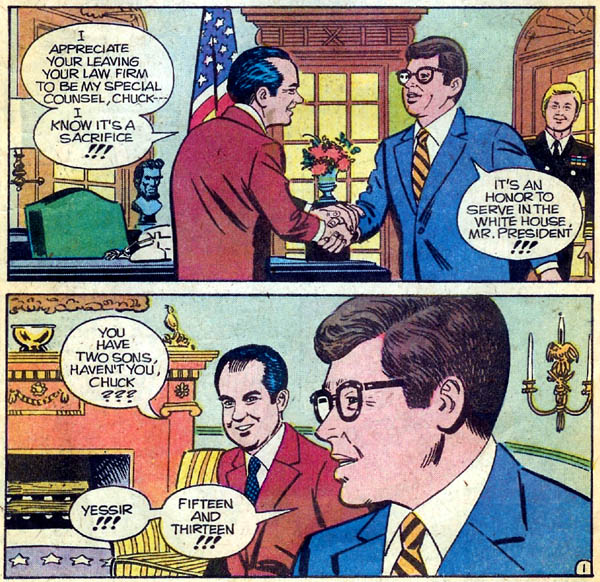
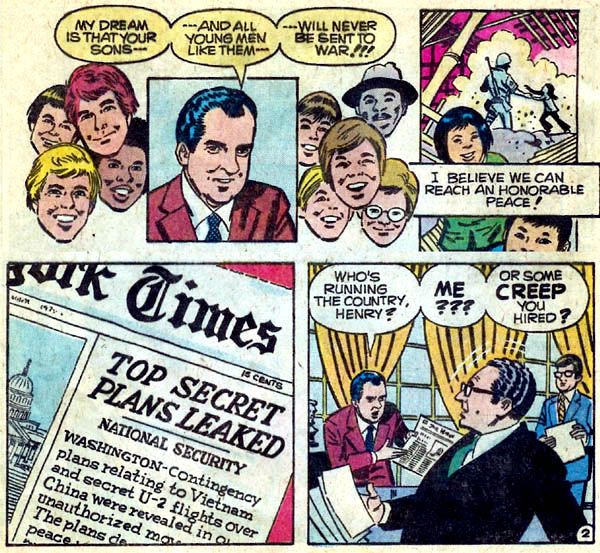
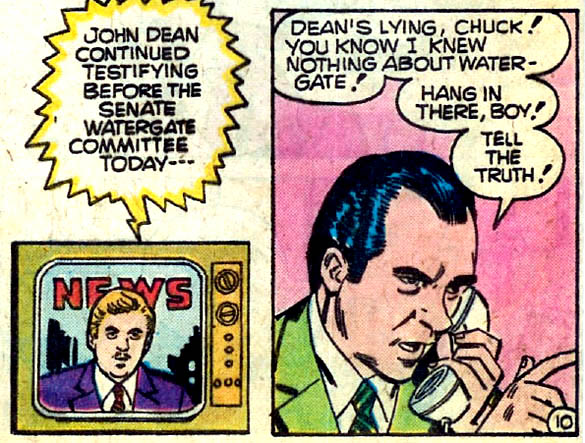
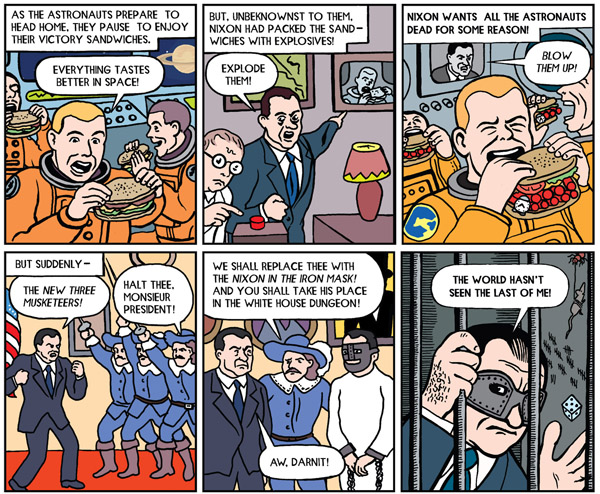
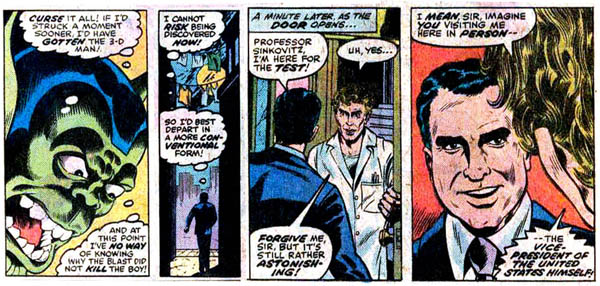
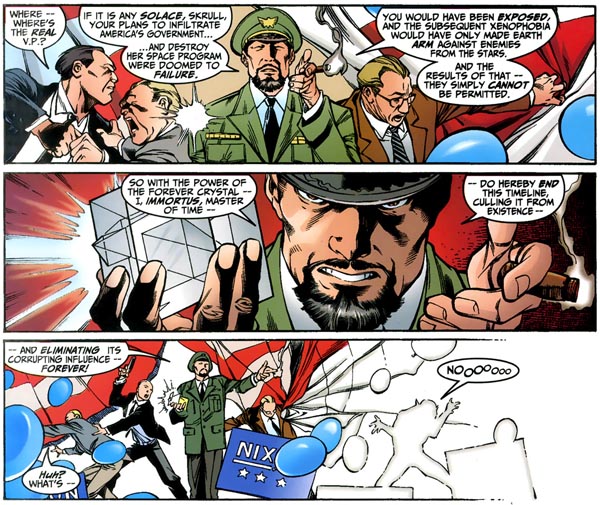
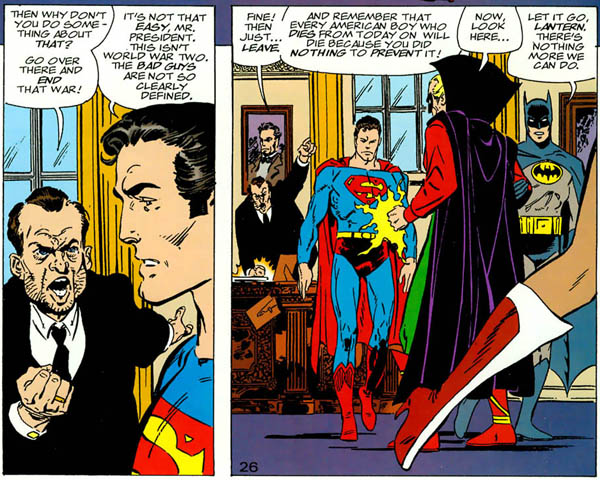
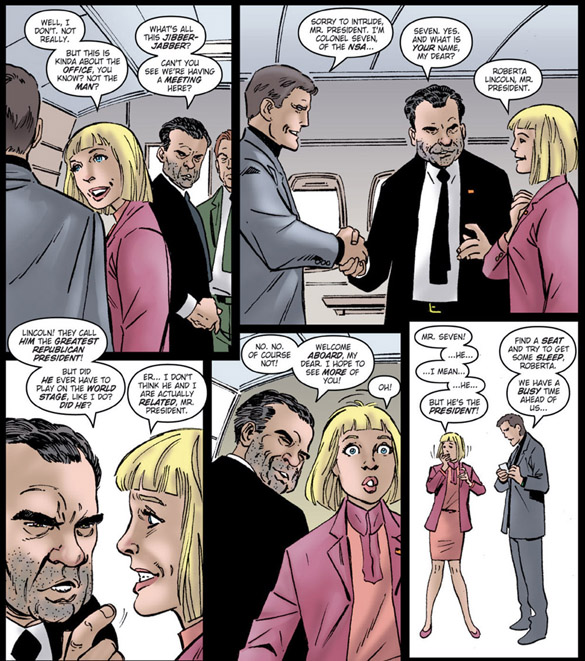
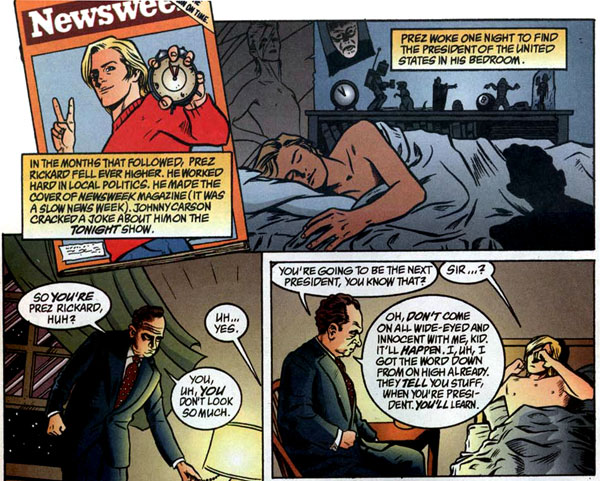
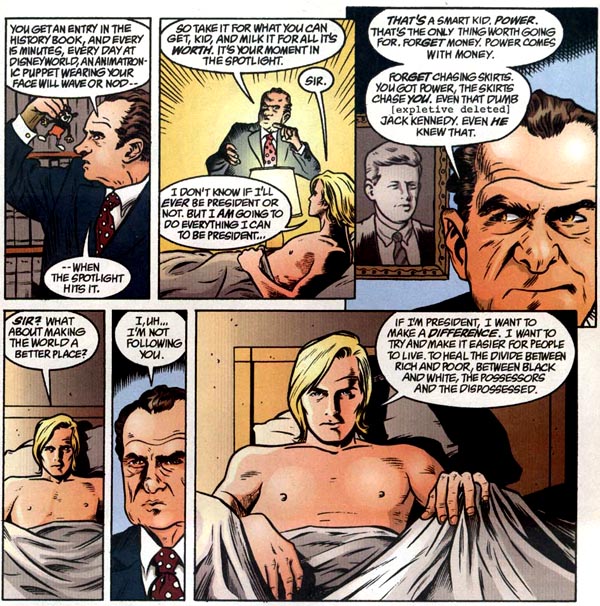
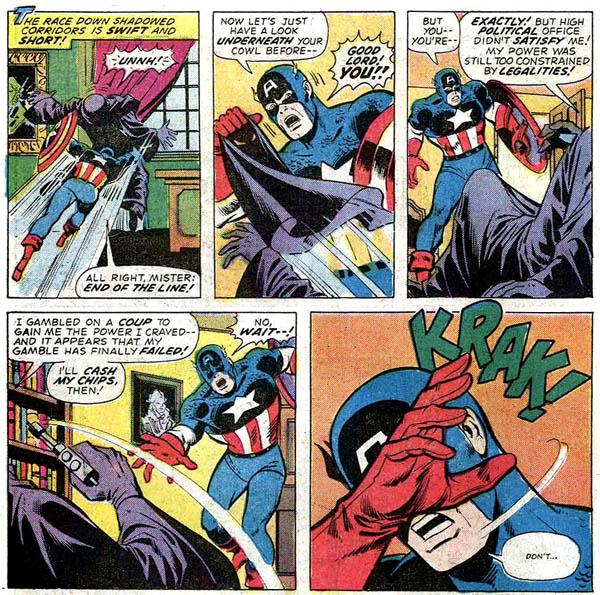
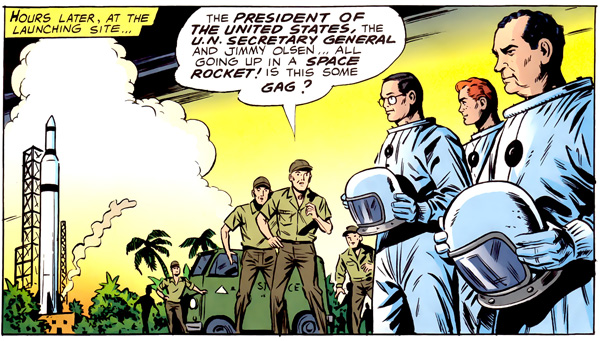
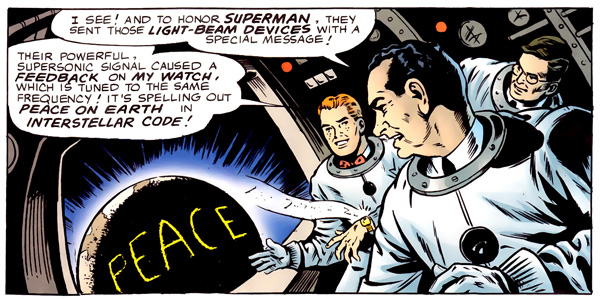
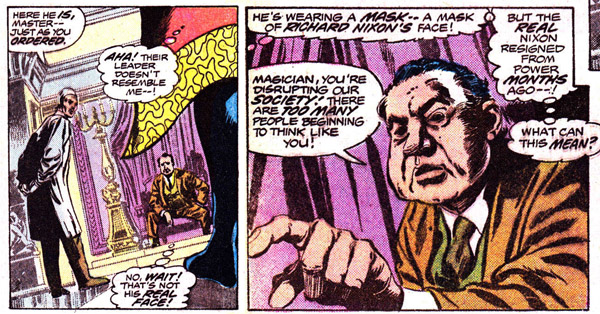
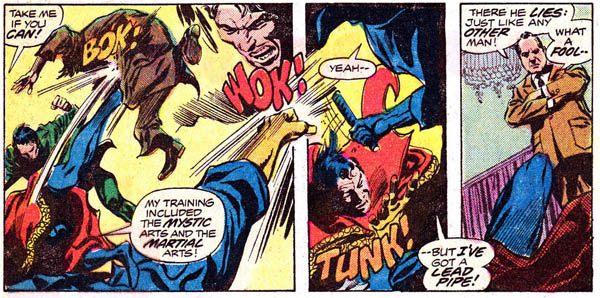

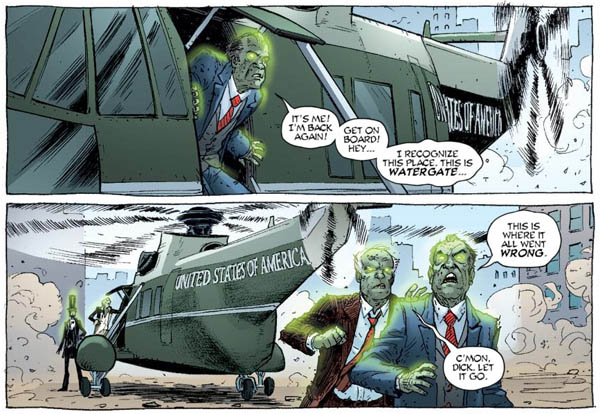
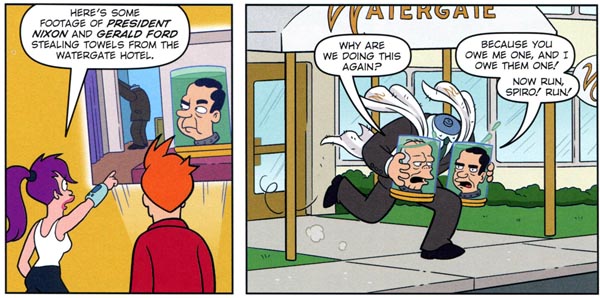
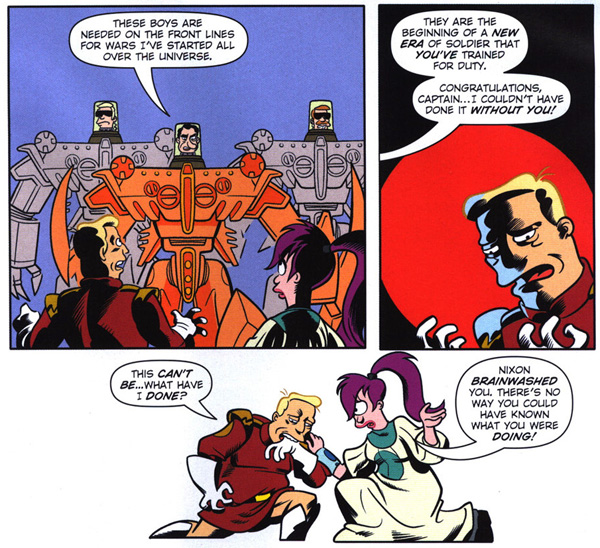

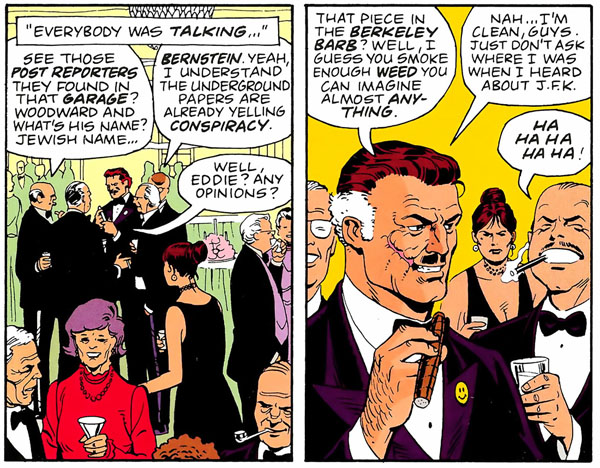
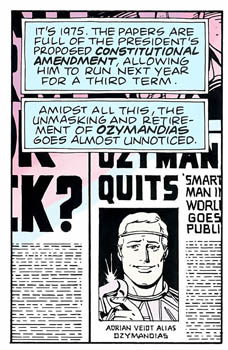
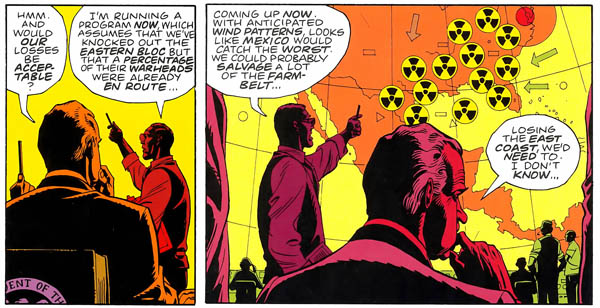
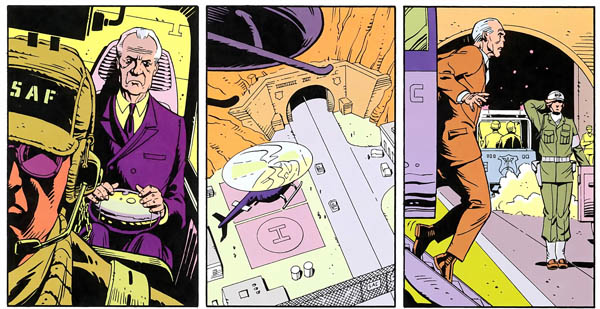
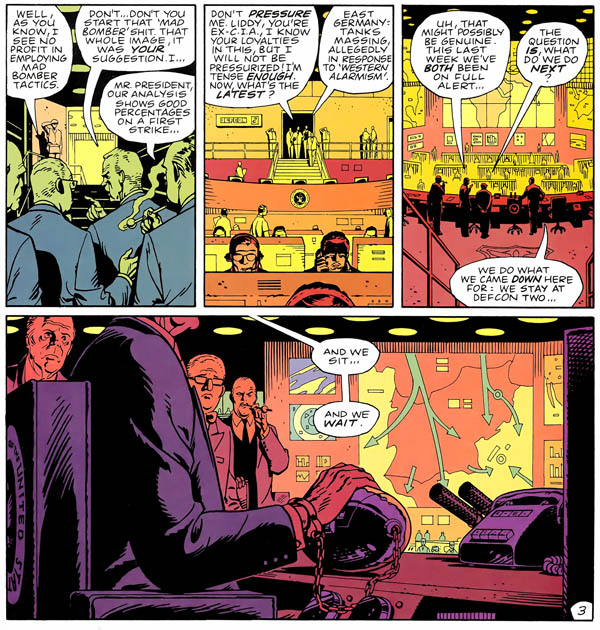
February 17, 2014
I was surprised you left out that Marvel Hulk storyline in which the Man-Beast becomes president of a parallel Earth. Though we only see him in his Man-Beast form, it’s clearly implied that his human form is Nixon.
February 17, 2014
That was sadly one of the ones I reluctantly had to cut out when it looked like this article was about to turn into 101 appearances of Nixon in comic books, Tom! (AND the time he attended the wedding of Superman and Lois Lane!) On the bright side…2015 sequel?!?
February 18, 2014
Nice compilation of Nixon appearances.
June 17, 2015
In a Marvel vs DC comic, Captain Marvel Jr is amalgamated with Captain America to form Captain America Jr. His magic word is Uncle Sam instead of Shazam, and he apparently takes his powers from former presidents. For example, as he tricked an enemy into defeat, he says “That took the trickery of Nixon, but it worked.”
February 20, 2017
One of the first Fantastic Four comics I ever read–a reprint, post-Kirby, guest starring Magneto and Namor–featured Nixon, and a weird, phonetic spelling of how he said “America” as “Amahrica.” It took YEARS for Little Kid Me to parse all of that out…